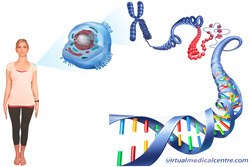- What is Gaucher Disease?
- Statistics
- Risk Factors
- Progression
- Symptoms
- Clinical Examination
- How is it Diagnosed
- Prognosis
- Treatment
- References
What is Gaucher Disease?

There are three subtypes of Gaucher disease:
- Type 1 Gaucher disease is the most common form, and is the least serious.
- Type 2 Gaucher disease is rare, and fatal in the early stages of life.
- Type 3 Gaucher disease is an intermediate form between types 1 and 2.
Type 1 Gaucher disease is also known as non-neuronopathic GD, whilst type 2 and type 3 Gaucher disease are commonly classified as neuronopathic GD. Non-neuronopathic GD (type 1 GD) can be acute or subacute. Neuronopathic GD can be subclassified on the basis of central nervous system involvement.
Statistics
The estimated wordwide prevalence of Gaucher disease is 1 per 40,000 to 1 per 75,000 births. In Australia, the prevalence is estimated at 1 in 57,000 live births.
Type 1 Gaucher disease makes up approximately 90% of cases of Gaucher disease in Australia, and has an increased prevalence amongst Ashkenazi Jewish populations.
In contrast, types 2 and 3 are rare and affect only 1 in 100,000 to 1 in 150,000 births.
Risk Factors
Gaucher disease is a genetically inherited autosomal recessive disorder. To pass it on to a child, both parents need to be either affected by Gaucher disease or by asymptomatic carriers of the disease.
Gaucher disease is known to have a higher prevalence amongst certain cultural and religious groups, including Ashkenazi Jews, and a number of non-Jewish European populations, including Northern Sweden.
Progression
The progression of Gaucher disease is heavily dependent upon the subtype of the disease that an individual inherits, as well as the age of onset of the disease.
Type 1 Gaucher disease
In general terms, type 1 Gaucher disease appears in adulthood and has a slow and indolent progression. Many individuals are able to live a full life using only symptomatic relief for their symptoms. However, if type 1 Gaucher disease manifests early in life, progression of the disease tends to be more abrupt, and more extensive treatment is usually required.
Type 2 Gaucher disease
Type 2 Gaucher disease usually manifests before 2 years of age and is universally fatal within 2 years.
Type 3 Gaucher disease
Type 3 Gaucher disease has the most varied course and outcomes, with a life expectancy of 20–40 years. In terms of symptoms and progression, it lies in between type 1 and type 2 Gaucher disease. It has an earlier onset and a more pronounced progression than type 1.
Three subtypes of type 3 Gaucher disease have been classified:
- Type 3a: Found in Northern Sweden, typically showing symptoms of early dementia.
- Type 3b: Predominantly bone, liver and spleen involvement with some neurological symptoms.
- Type 3c: Rare, with cardiovascular and neurological symptoms.
Symptoms
Gaucher disease has a widespread effect on the body, including the enlargement of the liver and spleen which may or may not be symptomatic. This can appear as early satiety, abdominal bloating or discomfort, weight gain or increase in abdominal girth.
Gaucher disease can cause bone pain, fatigue due to anaemia, recurrent bleeding disorders (e.g. nose bleeds, heavy periods), painful and enlarged lymph nodes, and recurrent fractures. Affected individuals may also feel tired and generally unwell.
In type 3 Gaucher disease, there may be neurological symptoms affecting vision and cognition.
Clinical Examination
A thorough clinical examination is required if a medical practitioner is exploring the possibility of Gaucher disease. This includes an abdominal examination to look for an enlarged liver or spleen, a cardiorespiratory examination to look for signs in the lungs, and an examination of lymph nodes. Blood tests should also be performed to investigate fatigue and easy bleeding and bruising.
If neurological involvement is suspected, a specialist eye and neurological assessment will also be required.
How is it Diagnosed
The definitive method of diagnosing Gaucher disease is by performing a blood test to look at the levels of the defective enzyme.
A number of methods can provide useful information, including:
- Positive clinical examination findings;
- Laboratory investigations (e.g. blood tests, biochemical markers, genotyping and DNA analysis);
- Specialised MRI scans; and
- Bone marrow biopsy if required.
Prognosis

Type 2 Gaucher disease is universally fatal within two years.
Type 3 Gaucher disease has a life expectancy of 20 to 40 years. However, recent advances in medical therapy are likely to extend the length and quality of life of individuals with type 3 Gaucher disease.
Treatment

Symptomatic relief
In the event that adult patients with type 1 Gaucher disease are only mildly affected, symptomatic relief (e.g. pain control, blood transfusions, and treatment of infective exacerbations) may be all that is required. Careful and regular monitoring should be conducted to ensure that irreversible complications do not result from the disease.
Enzyme replacement therapy (ERT)
Enzyme replacement therapy is the current standard of care treatment for moderately to severely affected individuals with Gaucher disease. It aims to supplement the low levels of enzymes that are needed to break down the fat deposits caused by Gaucher disease.
The approved drug for this purpose is Cerezyme (imiglucerase). It is very expensive, so its use is restricted to symptomatic children and adults with moderate to severe disease. Cerezyme is funded by the Australian government under the Life Saving Drugs Program for people who meet specific criteria.
Individuals who are undergoing enzyme replacement therapy are required to have routine examinations, including an annual MRI scan, to monitor their treatment.
Substrate reduction therapy (SRT)
For individuals who cannot receive ERT because of treatment failure or unsuitability, an alternative medication is available that aims to reduce the production of fats that are deposited in organs around the body. This medication is called Zavesca (miglustat). It is not yet funded by the PBS or the Life Saving Drugs Program.
Bone marrow transplantation
Bone marrow transplantation is rarely used now, because complications were high and alternative treatments with ERT and SRT have proven to be just as effective.
Gene therapy
Gene therapy is a novel approach to treating Gaucher disease. It uses a virus to deliver the missing genes to blood stem cells. This method of treatment has only been trialled in mice and is yet to be proven in humans.
Genetic testing is an important consideration if Gaucher disease is a concern, or if individuals are aware of the disorder occurring in their family. Testing can be arranged to assess for the presence of genetic mutations which may lead to Gaucher disease in the tested individual. Testing can determine if an individual is a carrier of the disease and therefore estimate the risk of passing the disorder on to children.
References
- Kumar V, Abbas A, Fausto N. Robbins and Cotran Pathologic Basis of Disease. 7th edition. Philadelphia: Elsevier Saunders; 2005, pp 158-91.
- Elstein D, Abrahamov A, Hadas-Halpern I, Zimran A. Gaucher’s disease. Lancet. 2001; 358(9278): 324-7.
- Charrow J, Andersson HC, Kaplan P, Kolodny EH, Mistry P, Pastores G, et al. The Gaucher registry: Demographics and disease characteristics of 1698 patients with Gaucher disease. Arch Intern Med. 2000; 160(18): 2835-43.
- Pastores GM, Hughes DA. Gaucher Disease [online]. GeneReviews, University of Washington, Seattle. 13 March 2008 [cited 27 April 2009]. Available from URL: http://www.ncbi.nlm.nih.gov/ bookshelf/ br.fcgi?book=gene&part=gaucher
- Goker-Alpan O, Schiffmann R, Park JK, Stubblefield BK, Tayebi N, Sidransky E. Phenotypic continuum in neuronopathic Gaucher disease: An intermediate phenotype between type 2 and type 3. J Pediatr. 2003; 143(2): 273-6.
- Sidransky E. New perspectives in type 2 Gaucher disease. Adv Pediatr. 1997; 44: 73-107.
- Meikle PJ, Hopwood JJ, Clague AE, Carey WF. Prevalence of lysosomal storage disorders. JAMA. 1999; 281(3): 249-54.
- Grabowski GA. Gaucher disease: Gene frequencies and genotype/phenotype correlations. Genet Test. 1997; 1(1): 5-12.
- Grabowski GA. Recent clinical progress in Gaucher disease. Curr Opin Pediatr. 2005; 17(4): 519-24.
- Zuckerman S, Lahad A, Shmueli A, Zimran A, Peleg L, Orr-Urtreger A, et al. Carrier screening for Gaucher disease: Lessons for low-penetrance, treatable diseases. JAMA. 2007; 298(11): 1329-31.
- Mehta A. Epidemiology and natural history of Gaucher’s disease. Eur J Int Med. 2006; 17(Suppl): S2-5.
- Cooper D, Ball E, Stenson P, Phillips A, Howells K, Mort M. The Human Gene Mutation Database at the Institute of Medical Genetics in Cardiff [online]. Cardiff University. 2008 [cited 27 April 2009]. Available from URL: http://www.hgmd.cf.ac.uk/ ac/ index.php
- Koprivica V, Stone DL, Park JK, Callahan M, Frisch A, Cohen IJ, et al. Analysis and classification of 304 mutant alleles in patients with type 1 and type 3 Gaucher disease. Am J Hum Genet. 2000; 66(6): 1777-86.
- Dahl N, Lagerström M, Erikson A, Pettersson U. Gaucher disease type III (Norrbottnian type) is caused by a single mutation in exon 10 of the glucocerebrosidase gene. Am J Hum Genet. 1990; 47(2): 275-8.
- Cox TM. Gaucher disease: Understanding the molecular pathogenesis of sphingolipidoses. J Inherit Metab Dis. 2001; 24(Suppl 2): 106-21.
- Larsen EC, Connolly SA, Rosenberg AE. Case records of the Massachusetts General Hospital. Weekly clinicopathological exercises. Case 20-2003. A nine-year-old girl with hepatosplenomegaly and pain in the thigh. N Engl J Med. 2003; 348(26): 2669-77.
- Kaplan P, Andersson HC, Kacena KA, Yee JD. The clinical and demographic characteristics of nonneuronopathic Gaucher disease in 887 children at diagnosis. Arch Pediatr Adolesc Med. 2006; 160(6): 603-8.
- Rudzki Z, Okon K, Machaczka M, Rucinska M, Papla B, Skotnicki AB. Enzyme replacement therapy reduces Gaucher cell burden but may accelerate osteopenia in patients with type I disease – a histological study. Eur J Haematol. 2003: 70(5): 273-81.
- Ida H, Rennert OM, Ito T, Maekawa K, Eto Y. Type 1 Gaucher disease: Phenotypic expression and natural history in Japanese patients. Blood Cells Mol Dis. 1998; 24(1): 73-81.
- Beutler E. Commentary: The natural history of Gaucher disease. Blood Cells Mol Dis. 1998; 24(1): 82.
- Mignot C, Doummar D, Maire I, De Villemeur TB. Type 2 Gaucher disease: 15 new cases and review of the literature. Brain Dev. 2006; 28(1): 39-48.
- Tayebi N, Cushner SR, Kleijer W, Lau EK, Damschroder-Williams PJ, Stubblefield BK, et al. Prenatal lethality of a homozygous null mutation in the human glucocerebrosidase gene. Am J Med Genet. 1997; 73(1): 41-7.
- Mignot C, Gelot A, Bessières B, Daffos F, Voyer M, Menez F, et al. Perinatal-lethal Gaucher disease. Am J Med Genet A. 2003; 120A(3): 338-44.
- Blom S, Erikson A. Gaucher disease-Norrbottnian type. Neurodevelopmental, neurological, and neurophysiological aspects. Eur J Pediatr. 1983; 140(4): 316-22.
- Harris CM, Taylor DS, Vellodi A. Ocular motor abnormalities in Gaucher disease. Neuropediatrics. 1999; 30(6): 289-93.
- Bohlega S, Kambouris M, Shahid M, Al Homsi M, Al Sous W. Gaucher disease with oculomotor apraxia and cardiovascular calcification (Gaucher type IIIC). Neurology. 2000; 54(1): 261-3.
- Grabowski GA, Andria G, Baldellou A, Campbell PE, Charrow J, Cohen IJ, et al. Pediatric non-neuronopathic Gaucher disease: Presentation, diagnosis and assessment. Consensus statements. Eur J Pediatr. 2004; 163(2): 58-66.
- Vellodi A, Bembi B, de Villemeur TB, Collin-Histed T, Erikson A, Mengel E, et al. Management of neuronopathic Gaucher disease: A European consensus. J Inherit Metab Dis. 2001; 24(3): 319-27.
- Giraldo P, Cenarro A, Alfonso P, Pérez-Calvo JI, Rubio-Félix D, Giralt M, et al. Chitotriosidase genotype and plasma activity in patients type 1 Gaucher’s disease and their relatives (carriers and non carriers). Haematologica. 2001; 86(9): 977-84.
- Hollak CE, Maas M, Aerts JM. Clinically relevant therapeutic endpoints in type I Gaucher disease. J Inherit Metab Dis. 2001; 24(Suppl 2): 97-105.
- Beutler E, Saven A. Misuse of marrow examination in the diagnosis of Gaucher disease. Blood. 1990; 76(3): 646-8.
- Svennerholm L, Håkansson G, Lindsten J, Wahlström, J. Prenatal diagnosis of Gaucher disease. Assay of the beta-glucosidase activity in amniotic fluid cells cultivated in two laboratorieswith different cultivation conditions. Clin Genet. 1981; 19(1): 16-22.
- NIH Technology Assessment Panel on Gaucher Disease. Gaucher disease. Current issues in diagnosis and treatment. JAMA. 1996; 275(7): 548-53.
- Pastores GM, Weinreb NJ, Aerts H, Andria G, Cox TM, Giralt M, et al. Therapeutic goals in the treatment of Gaucher disease. Semin Hematol. 2004; 41(4 Suppl 5): 4-14.
- Weinreb NJ, Aggio MC, Andersson HC, Andria G, Charrow J, Clarke JT, et al. Gaucher disease type 1: Revised recommendations on evaluations and monitoring for adult patients. Semin Hematol. 2004; 41(4 Suppl 5): 15-22.
- Andersson HC, Charrow J, Kaplan P, Mistry P, Pastores GM, Prakash-Cheng A, et al. Individualization of long-term enzyme replacement therapy for Gaucher disease. Genet Med. 2005; 7(2): 105-10.
- Weinreb NJ, Charrow J, Andersson HC, Kaplan P, Kolodny EH, Mistry P, et al. Effectiveness of enzyme replacement therapy in 1028 patients with type 1 Gaucher disease after 2 to 5 years of treatment: A report from the Gaucher Registry. Am J Med. 2002; 113(2): 112-9.
- Prows CA, Sanchez N, Daugherty C, Grabowski GA. Gaucher disease: Enzyme therapy in the acute neuronopathic variant. Am J Med Genet. 1997; 71(1): 16-21.
- Altarescu G, Hill S, Wiggs E, Jeffries N, Kreps C, Parker CC, et al. The efficacy of enzyme replacement therapy in patients with chronic neuronopathic Gaucher’s disease. J Pediatr. 2001; 138(4): 539-47.
- Robertson P. Guidelines for MR assessment of Gaucher Disease in Adults [online]. Department of Health and Ageing, Australian Government. 16 May 2006 [cited 28 April 2009]. Available from URL: http://www.health.gov.au/ internet/ main/ publishing.nsf/ Content/ health-pbs-general-supply-mriguide
- Public Summary Document: Miglustat, capsule 100 mg, Zavesca® [online]. Department of Health and Ageing, Australian Government. 18 July 2008 [cited 28 April 2009]. Available from URL: http://www.health.gov.au/ internet/ main/ publishing.nsf/ Content/ pbac-psd-miglustat-mar08
- Elstein D, Dweck A, Attias D, Hadas-Halpern I, Zevin S, Altarescu G, et al. Oral maintenance clinical trial with miglustat for type I Gaucher disease: Switch from or combination with intravenous enzyme replacement. Blood. 2007; 110(7): 2296-301.
- Cox, T, Lachmann, R, Hollak, C, et al. Novel oral treatment of Gaucher’s disease with N-butyldeoxynojirimycin (OGT 918) to decrease substrate biosynthesis. Lancet 2000; 355:1481.
- Steward CG, Jarisch A. Haemopoietic stem cell transplantation for genetic disorders. Arch Dis Child. 2005; 90(12): 1259-63.
- Enquist IB, Nilsson E, Ooka A, Månsson JE, Olsson K, Ehinger M, et al. Effective cell and gene therapy in a murine model of Gaucher disease. Proc Natl Acad Sci USA. 2006; 103(37): 13819-24.
- Weinreb NJ, Deegan P, Kacena KA, Mistry P, Pastores GM, Velentgas P, et al. Life expectancy in Gaucher disease type 1. Am J Hematol. 2008; 83(12): 896-900.
- Taddei T, Kacena K, Yang M, Yang R, Malhotra A, Boxer M, et al. The underrecognized progressive nature of N370S Gaucher disease and assessment of cancer risk in 403 patients. Am J Hematol. 2009; 84: 208-14.
- Pharmaceutical Benefits Advisory Committee. Public Summary Document: Guidelines for Treatment of Gaucher Disease by Enzyme Replacement with Imiglucerase [online]. Department of Health and Ageing, Australian Government. 13 February 2006 [cited 18 May 2009]. Available from: http://www.health.gov.au/ internet/ main/ publishing.nsf/ Content/ 71D15BD1EE4A4A8DCA256F85007A7F66/ $File/ gguidelines.pdf
All content and media on the HealthEngine Blog is created and published online for informational purposes only. It is not intended to be a substitute for professional medical advice and should not be relied on as health or personal advice. Always seek the guidance of your doctor or other qualified health professional with any questions you may have regarding your health or a medical condition. Never disregard the advice of a medical professional, or delay in seeking it because of something you have read on this Website. If you think you may have a medical emergency, call your doctor, go to the nearest hospital emergency department, or call the emergency services immediately.







